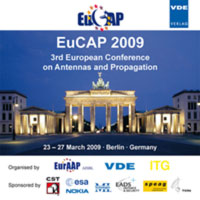Multi-Band Diversity Antenna Performances Evaluation for Multi-Standard Compact Wireless Terminal
Conference: EuCAP 2009 - 3rd European Conference on Antennas and Propagation
03/23/2009 - 03/27/2009 at Berlin, Germany
Proceedings: EuCAP 2009
Pages: 5Language: englishTyp: PDF
Personal VDE Members are entitled to a 10% discount on this title
Authors:
Mouhamadou, Moctar; Koubeissi, Majed; Tounou, Charles; Decroze, Cyril; Carsenat, David; Monedière, Thierry (XLIM-UMR CNRS no. 6172, OSA department, University of Limoges, 123 av. Albert Thomas, 87060 Limoges cedex, France)
Reynaud, Sebastien (CISTEME, Ester Technopôle, 87069 Limoges cedex 3, France)
Abstract:
Multiple antennas systems or spatial diversity plays an important role in combating fading radio channels and minimizing signal loss. The main challenge of antenna diversity in practical application is the integrated multiple antennas on a mobile terminal. This paper presents a compact multiband diversity antenna system for multi-standard application. The presented multi-band antenna is operating in the IEEE 802.11b,g (2.4-2.48 GHz), IEEE 802.11a (5.15-5.35 GHz, 5.72-5.85 GHz), HIPERLAN2 (5.4-5.72 GHz) and IEEE 802.16 (3.4-3.6 GHz) frequency bands. The performance of this compact multi-band diversity antenna is evaluated in terms of envelope correlation coefficient and Diversity Gain in statistically uniform propagation channel. The envelope correlation coefficient is still less than 0.05 over the whole desired frequencies bands. The simulated Diversity Gain (DG) is equal to 12.5 dB and 10.6 dB at 1% probability for the 2.44 and 3.49 GHz frequencies, respectively, using Maximum Ratio Combining (MRC) technique.


